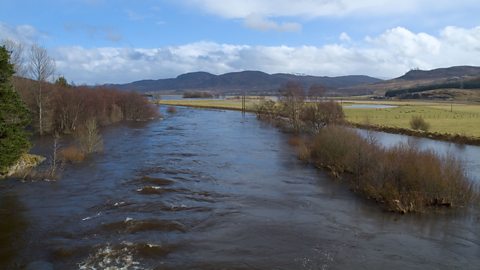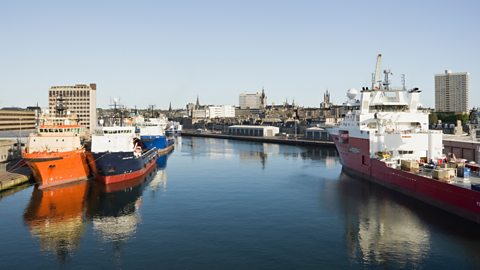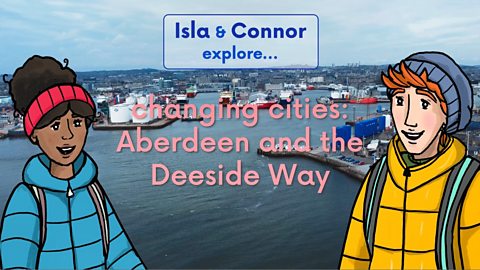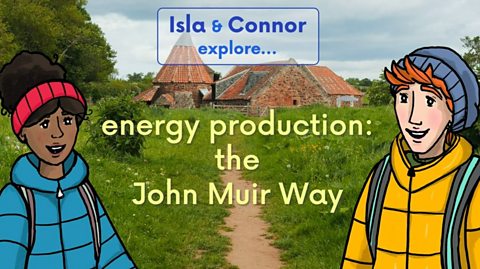What is the lower course of a river?
The end of a river is called the lower course. This is where the river flows into another body of water, like the sea or another river.
In this article you can learn about:
- Features of a river's lower course
- How an island can form in a river
- What a floodplain is
- Life by the sea
This article is suitable for Landscapes topics for primary school learners.
Video - Lower course of the River Tay
Join Isla and Connor as they explore what happens in the lower course of the River Tay.
ISLA: Weāve reached the lower course of the River Tay! It already feels so different from the upper and middle courses. Oh wow, Moncrieffe Island up ahead!
CONNOR: In the lower course the river slows down as it flows across flatter land towards the sea. Because it is slower, it loses energy and canāt carry sand and sediment. It drops it, which is called deposition, and creates features like islands. Over time, vegetation and plants grow and their roots help make the island stable. It becomes a permanent feature thatās hard toā¦wash away!
ISLA: Oh no! Meet you at the other end!
Does anyone live on it?
CONNOR: No, it floods when there is a lot of heavy rain or snowmelt. A lot of the area is part of the floodplain ā the land next to the river that floods if it rains too much. When that happens, the river overflows and spills into the town, city or surrounding area.
ISLA: Dundee! Weāve travelled nearly 188 kilometres! Soon weāll pass through the riverās mouth and out to sea.
CONNOR: The river gets really wide here doesnāt it.
Bleurgh. And salty!
WOAH! Phew. These big boats carry goods from all around the world into the port. Itās the reason why Dundee is here in the first place ā it thrived because of trade.
ISLA: Thanks to the Tay that started waaaay up in the mountains. It all looks and sounds very different up there.
A busy waterway needs a lifeboat to help people who get into trouble too.
CONNOR: Yeah, Iāll say. Iām glad these guys are here!
Thereās lots of life here. All the sand and silt is rich in nutrients, which is great for plants and tiny animals. And theyāre great food for the bigger animals.
ISLA: Weāre at the end of the river! Woohoo!
CONNOR: Woohoo!
ISLA: Get in Connor, say āwe did it!ā
CONNOR & ISLA: We did it!
CONNOR: Iām already planning the next one. Thereās the River Nith, the Forth, the Clyde, the Spey, the Tweedā¦ooh we could go mountain climbing, Iāve always fancied climbing Ben Nevisā¦
What is a river?
- A river is a moving body of water that flows from its sourceWhere a river starts. This is usually up high, like on top of a mountain. into another body of water, like the sea.
- A river is split into three parts: the upper course, middle course and lower course.

What is the lower course of a river?
- The lower course is the end of a river. It flows into another body of water. This could be the sea, an ocean, a loch or another river.
- In the lower course, the river channelThe space taken up by a river. The passage that the river water travels along. is deep and wide and full of lots of water.
- The landscape around the lower course is flat, which means it has a wide floodplainThe flat area that stretches from a river to the sides of a valley. The floodplain will often become covered in water in times of flood..
- As a river reaches the end of its journey, energy levels are low and the currentA river current is the flow of water being pulled by gravity as the water moves downhill. slows down.
- In the lower course, the water doesn't have enough energy to carry material, like sand and sediment so the river drops it. ThisdepositionWhen a river cannot carry material, like sand and gravel, so it is dropped or dumped within the river channel. creates features like islands.
- The area where a river ends when it meets another body of water, like the sea, is called the river mouth.
Physical features of the lower course of a river
This slideshow shows some examples of lower course features.

Image caption, Floodplains
The lower course of a river has a wide floodplain. When there is a lot of rain or snowmelt, rivers can overflow. Water can flood a very wide area of the floodplain because it is so flat.
Image caption, Islands
Islands, like Moncrieffe Island on the River Tay, are formed in a river's lower course. The water moves more slowly here, so it deposits sand and silt which can grow to form islands.
Image caption, River mouth
A river's mouth is where it meets another body of water. In this photograph, the mouth of the River Naver meets the sea on the north coast of Scotland.
1 of 3
Life by a river mouth
Many rivers flow out to sea. Find out about life around river mouths and estuaries in this slideshow.

Image caption, Ships, ports and trade
Big boats carry goods from all over the world into ports. In the past, cities like Dundee and Aberdeen (pictured) thrived on shipping trade. Many shipping ports were built at the mouth of rivers and canals because of their access to the sea and to towns further up river.
Image caption, Lifeboats
Busy waterways can be dangerous. Lifeboats are needed to keep people safe and rescue them if they get into trouble.
Image caption, Wildlife: Worms
The land around a river mouth is rich in nutrients deposited by the river, so beaches and mudflats are home to many tiny animals, like shellfish and worms. If you visit the coast, you might see casts left behind by Estuary Ragworms or Lugworms (pictured) who live in the fertile sand, silt and mud.
Image caption, Widlife: Oystercatchers
Oystercatchers can be found around the Scottish coast. These birds like to eat worms, cockles and mussels and use their long bills to search for food in the sand and mud.
Image caption, Wildlife: Seals
Harbour seals can often be spotted on Scotland's coastline. They spend most of their time in the water where they hunt for fish to eat. Firth of Tay and Eden Estuary is a Harbour seal Special Area of Conservation, set up to protect seals that live and breed here.
1 of 5
In the past, cities like Dundee and Aberdeen thrived on shipping trade. Learn more about these changing cities here:

Key words about a river's lower course
- lower course - The final section of a river which flows into another body of water which could be a loch, the sea, an ocean or even another river. A river's lower course is slower and has less energy to carry material, like sand and sediment.
- deposition - When water loses energy, it drops the material it has been carrying, like sand and gravel.
- island - A piece of land that is completely surrounded by water. Over time, a river drops lots of sand and sediment. Vegetation and plants begin to grow in these areas and their roots make the island stable.
- floodplain - The land next to a river that floods if it rains too much. When this happens, the river overflows into the surrounding area. The landscape around the lower course is flat so it is more prone to flooding.
- river mouth - Where a river meets an ocean, sea or loch. The river deposits a lot of the gravel, sand, silt and clay that it has been carrying at the river's mouth.
- port - A place where ships and boats are loaded and unloaded. This is where people and cargo can go between land and sea.
- harbour - A safe place where boats can be docked.
Test your knowledge
Quiz
Try this short multiple choice quiz to test your knowledge of the lower course.
Challenge

Write a fact file about a port or harbour near you.
A fact file is a short report of the most important information about one subject. This subject can be a thing, a place or even a person.
Some examples of ports and harbours in Scotland include: Aberdeen, Glasgow, Greenock, Leith and Dundee.
Here are some tips for writing your report:
- Before your create a fact file, it is important to research the subject. Make organised notes in preparation for writing your final fact file.
- When you are ready to write your fact file, start with a large clear title.
- Write a short introduction to let the reader know what you are writing about.
- Break up your information with subheadings.
- Using your research, write clear detailed paragraphs under each heading.
- Include pictures to make your fact file more interesting.
- Your fact file should use formal language and shouldn't include any of your opinions.
If you need some more help writing your fact file, you can get more information here: How to write a report
More on Landscapes
Find out more by working through a topic
- count1 of 25

- count2 of 25

- count3 of 25

- count4 of 25
